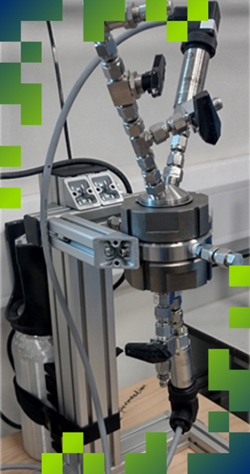Powering our future
Being able to produce, distribute and effectively use hydrogen can play a massive role in the decarbonisation of a wide range of industries such as manufacturing, transport, heat and general power.
By 2030, there will be an estimated 10 GW of low carbon hydrogen production capacity, enough to power the electricity of 10,000 homes for a year* (about the size of Teddington – where our main laboratory is based). Looking ahead, hydrogen is set to account for 20-35% of all electricity use in the UK by 2050.
With the development of such a new and critical infrastructure comes a multitude of measurement challenges. Scientists from our advanced materials team completed a Henry Royce project with the University of Manchester and the University of Warwick to characterise the performance of new nanocomposite liners in hydrogen fuelled vehicles.
We interviewed the project team to find out more.
Tell us a bit about this collaboration – how did it come about?
We had been engaged in an ongoing discussion with the University of Manchester as we were both developing similar hydrogen permeability testing kits in our labs and were comparing results. At the same time, the University of Warwick were producing materials for use as hydrogen barriers. This seemed like a perfect opportunity to all work together to help push things forward in developing hydrogen solutions.
Our team investigated the barrier properties of a novel thermoplastic polymer system with 2D boron nitride nanoparticles, developed by the University of Warwick. We assessed the permeability of hydrogen gas through the material at pressures up to 100bar.
How exactly does powering vehicles with hydrogen work?
Powering vehicles with hydrogen requires the use of strong, lightweight structures, with excellent gas barrier properties, to store the gas and prevent it from escaping. The use of liners with enhanced resistance to hydrogen permeation enables the fuel tanks and pipelines to be constructed using polymer composites, providing the structural properties required.

What impact will work like this have on a hydrogen-powered future?
The results of this project have significantly advanced our understanding of nanocomposite liners and the role they play as effective hydrogen barriers. This allows us to refine our requirements for future composite materials and screen out any unsuitable materials. It will help develop the capability to hone in on the most effective materials for gas transport and storage with less testing - saving time and cost for large-scale future projects.
What comes next for the team?
Our team will continue to collaborate with the Universities of Manchester and Warwick to test composite materials, whilst looking to build out the UK’s testing capability. There is a possibility for the University of Warwick and University of Bristol to develop their own equipment which will provide enhanced comparability to our research.
* Measurement Challenges in the Hydrogen Sector, National Physical Laboratory, July 2024
** NPL estimate (assuming 100 % uptime)
Read the report about the future hydrogen landscape